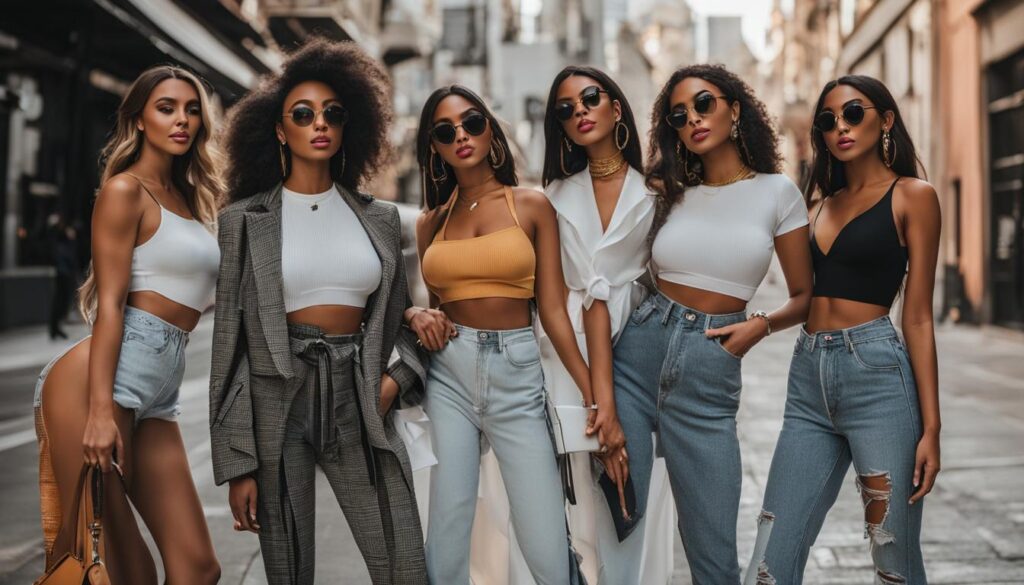Welcome to my article on influencer marketing. In today’s digital age, connecting with consumers through social media has become essential for businesses. One of the most effective strategies to increase brand visibility and reach is influencer marketing. By collaborating with social media influencers, brands can tap into their massive and engaged audience to promote products or services.
In this section, I will provide you with an overview of influencer marketing, the power of social media influencers, and how brands can leverage influencer collaborations and partnerships to maximize their impact. We will also discuss the importance of influencer outreach, crafting effective influencer campaigns, and the role of influencer strategy, engagement, and analytics in measuring success.
The Rise of Influencer Marketing in the Social Media Landscape
Influencer marketing has become a game-changer in the digital sphere, revolutionizing advertising strategies and shaping consumer behavior. Collaborations with popular social media personalities have paved the way for brands to engage with their target audience in a more authentic and impactful manner.
Traditionally, advertising strategies focused on mass communication and one-way conversations with consumers. However, influencer marketing has disrupted this approach by leveraging the power of personal connections and genuine endorsements. Influencers, who have built a loyal following based on their expertise, relatability, or unique perspectives, serve as influential figures that consumers trust and listen to.
This shift towards influencer marketing has had significant implications in the digital space. Brands now have the opportunity to leverage the influence of these social media stars to drive sales, increase brand awareness, and establish a deeper connection with their target audience. The competitive landscape has also been transformed, with brands vying for attention and seeking innovative ways to collaborate with influencers to stand out.
The Impact on Advertising Strategies
Influencer marketing has forced brands to rethink their advertising strategies and adapt to the changing dynamics of consumer behavior. Traditional forms of advertising, such as television commercials and print ads, are no longer as effective in capturing consumer attention. Instead, brands are increasingly investing in influencer partnerships to create more organic and relatable content that resonates with their target audience.
By leveraging the reach and influence of social media personalities, brands can tap into new and engaged consumer segments that might have previously been out of their reach. This shift towards influencer marketing has compelled brands to embrace more creative and authentic ways to promote their products or services.
The Influence on Consumer Behavior
The rise of influencer marketing has had a profound impact on consumer behavior. With the proliferation of social media platforms, consumers now have access to a wealth of information and recommendations from their favorite influencers. These genuine endorsements, coupled with the influencer’s personal experiences and storytelling, heavily influence a consumer’s purchasing decisions.
Consumers are no longer solely swayed by traditional advertising messages; they now seek out authentic experiences and recommendations from influencers they trust. This shift in consumer behavior has prompted brands to establish relationships with influencers who align with their values, target audience, and brand objectives.
The Future of Marketing in the Digital Sphere
Influencer marketing is here to stay, and its impact on the marketing landscape will continue to evolve. As consumer preferences and technology advance, brands will need to adapt and embrace new strategies to maximize their influencer collaborations effectively.
Brands will also need to navigate the ever-changing digital sphere, keeping up with emerging platforms and trends to maintain their competitive edge. The rise of short-form video content, the growth of niche influencer categories, and the increasing importance of data analytics are just a few trends shaping the future of influencer marketing.
| Influencer Marketing Trends | Implications |
|---|---|
| Rise of micro-influencers | Enables brands to tap into niche markets and drive targeted engagement |
| Video content domination | Requires brands to adapt and prioritize video content creation for maximum impact |
| Impact of Gen Z influencers | Brands must connect with the next generation by collaborating with influencers who resonate with Gen Z values and preferences |
| Data-driven influencer campaigns | Empowers brands to measure the success of their influencer campaigns and optimize for better results |
The Unique Role of Instagram in Influencer Marketing
Instagram has revolutionized digital photography and transformed the landscape of social media marketing. With its visually appealing interface and emphasis on captivating content, Instagram has become a go-to platform for influencers and brands alike.
On Instagram, influencers can showcase their creativity and connect with their audience in a unique and engaging way. The platform’s emphasis on visual content allows influencers to capture attention and create a lasting impression. By curating visually appealing feeds, influencers can effectively communicate their personal brand and attract a loyal following.
Brand engagement on Instagram is also unparalleled. Through carefully crafted posts, stories, and videos, influencers can build genuine connections with their audience, fostering a sense of trust and authenticity. This level of engagement translates into brand loyalty, as followers develop a strong affinity for the influencers they follow and the brands they endorse.
The power of Instagram influencer marketing lies in its ability to humanize brands and establish real-time connections. By partnering with influencers, brands can tap into the influencer’s credibility and reach, gaining exposure to a wider audience. This collaborative approach allows brands to leverage the influencer’s influence to drive sales and increase brand awareness.
Exploring the Different Types of Instagram Influencers
Instagram influencers play a significant role in the world of influencer marketing, with their ability to captivate and engage large audiences. They can be categorized into four types based on their follower count: mega-influencers, macro-influencers, micro-influencers, and nano-influencers.
Mega-influencers are the celebrities of Instagram, boasting millions of followers. They have established themselves as household names and have the potential to reach a massive audience. Collaborating with mega-influencers can greatly amplify brand exposure and generate significant buzz.
Macro-influencers have a substantial following, typically ranging from 100,000 to a million followers. They have built a strong personal brand and have a dedicated fan base. Partnering with macro-influencers allows brands to tap into a relevant and engaged audience.
Micro-influencers have a more niche audience, typically ranging from 10,000 to 100,000 followers. They may specialize in a specific industry or interest, building a loyal and highly engaged community. Collaborating with micro-influencers can provide brands with access to a highly targeted and receptive audience.
Nano-influencers have a smaller follower count, often ranging from a few thousand to 10,000 followers. Despite their lower reach, nano-influencers offer unique advantages for brands. They are known for their authenticity, close connections with their followers, and high engagement rates. Working with nano-influencers can help brands establish a sense of trust and credibility with their target audience.
When choosing an influencer to collaborate with, it is important to consider various factors such as engagement rates, niche expertise, and brand alignment. Each type of Instagram influencer offers different marketing potential, and selecting the right influencer for a campaign can significantly impact its success.
Overview of Instagram Influencer Types
| Influencer Type | Follower Count | Advantages |
|---|---|---|
| Mega-Influencers | Millions | Massive reach, widespread exposure, celebrity status |
| Macro-Influencers | 100,000 – 1 million | Relevant audience, strong personal brand, dedicated fan base |
| Micro-Influencers | 10,000 – 100,000 | Highly targeted audience, engaged community, niche expertise |
| Nano-Influencers | Few thousand – 10,000 | Authenticity, trust, high engagement rates, tight-knit connections |
Understanding the different types of Instagram influencers and their respective advantages can help brands make informed decisions when planning influencer marketing campaigns. The size and engagement of an influencer’s audience should be weighed against the campaign’s objectives and target audience to ensure maximum impact and effectiveness.

Conclusion
Influencer marketing is an essential strategy for businesses looking to enhance their brand awareness and engagement on social media. Throughout this article, we have explored the benefits of influencer marketing, the significance of different types of influencer content, and the ways to measure the success of influencer campaigns.
By leveraging the power of influencers, brands can tap into their large and engaged audience, increasing brand visibility and reaching new potential customers. Collaborating with influencers allows brands to create authentic and relatable content that resonates with their target audience, ultimately driving brand awareness and recognition.
Measuring the success of an influencer campaign is crucial in understanding its impact on brand awareness. By tracking metrics such as reach, engagement, and conversions, brands can evaluate the effectiveness of their influencer marketing efforts and make data-driven decisions to optimize future campaigns.
In conclusion, influencer marketing has proven to be a valuable tool for brands to elevate their brand awareness, engage with their target audience, and generate meaningful results. By incorporating influencer marketing into their overall marketing strategy, brands can unlock new opportunities for growth and establish a strong presence in the digital landscape.
FAQ
What is influencer marketing?
Influencer marketing is a strategy where businesses collaborate with social media influencers to promote their products or services to a large and engaged audience.
How can influencer collaborations benefit my brand?
Influencer collaborations can help increase brand visibility, reach a wider audience, build brand loyalty, and drive sales through endorsements and recommendations from trusted influencers.
What is the role of Instagram in influencer marketing?
Instagram has revolutionized influencer marketing by providing a platform for influencers to visually showcase their creativity, connect with their audience, and build brand engagement through visually appealing content.
What are the different types of Instagram influencers?
Instagram influencers can be categorized into four types based on their follower count: mega-influencers (1 million+ followers), macro-influencers (100,000-1 million followers), micro-influencers (10,000-100,000 followers), and nano-influencers (fewer than 10,000 followers).
How do I choose the right influencer to collaborate with?
When choosing an influencer, consider their engagement rates, niche expertise, brand alignment, and the target audience you want to reach. Each category of influencers offers unique benefits, so choose one that aligns with your brand goals and target audience.
How can I measure the success of an influencer campaign?
To measure the success of an influencer campaign, you can track metrics such as brand awareness, engagement rates, website traffic, conversions, and sales attributed to the campaign. Utilize influencer analytics tools and track key performance indicators to assess the campaign’s effectiveness.

I help businesses optimize their online presence and reach more customers through search engines. I have been working in this field for over a year, and I have earned certifications from various platforms. I have experience in conducting SEO audits, developing link building strategies, and implementing SEO best practices for various clients across different industries. I am proficient in SEO tools, such as Google Analytics, Google Search Console, Moz, and Ahrefs. I am passionate about SEO and always eager to learn new skills and techniques to improve my performance and deliver results. My goal is to become a SEO leader and help businesses grow and succeed online.
